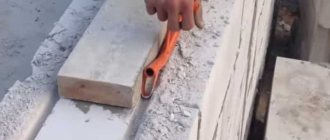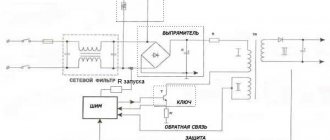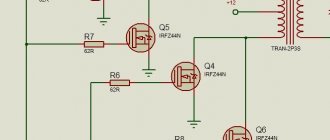To install communications in the walls, you will need to use a specialized tool - a wall chaser. It is rational to buy it for professionals who are engaged in repair and construction work, in particular for electricians, plumbers, plumbers, etc. If repairs are carried out independently in a house or apartment, then it is not necessary to buy a specialized tool, since you can make a wall chaser attachment for an angle grinder. How this can be done with the least investment is described in detail in the material.
Purpose of a wall chaser, what can you do with it?
A highly specialized tool called a wall chaser is similar to an angle grinder or simply an angle grinder. A wall chaser, unlike an angle grinder, is designed directly for making grooves in walls with further installation of various communications in them, such as wires and cables, water and sewer pipelines, as well as other devices.
The wall chaser has two parallel disks for concrete; the distance between them can be adjusted depending on the technological task. This allows you to prepare a groove in the wall of the required width. This highly specialized tool also has a function for adjusting the depth of the groove being made. The required value of groove deepening is selected by moving the cutting discs, and depending on the technological task.
A wall chaser is quite expensive, and it is used exclusively for chasing walls, so not everyone can afford such a purchase. To avoid having to buy a highly specialized tool, you can make it yourself from a grinder. The design of a wall chaser is similar to an angle grinder, so it makes sense to use a grinder to make a tool for making grooves in the wall.
This is interesting!
A grinder without additional devices can be used as a cutting tool, for which a special diamond disc for concrete should be fixed in the spindle of the device.
The inconvenience of using an angle grinder as a wall chaser is that adjusting the depth and width of the groove requires skill from the worker. A special casing made by yourself will help replace this skill, and at the same time simplify the process of wall slitting. The special casing on the angle grinder allows you to get the following advantages:
- Savings on purchasing specialized tools
- Ease of work
- Carrying out dust-free work on making grooves in residential and non-residential premises
In addition to a specialized wall chaser, you can make a groove in the wall for laying communications using the following tools:
- Grinder or angle grinder of different brands
- Hammer
- A hammer with a chisel is the simplest and most economical option, but the rationality of its use is determined by the volume of planned work
Manufacturers produce wall chaser attachments for angle grinders, which can be purchased at any tool store or ordered in an online store. By purchasing such a nozzle, you eliminate the need to make it yourself. However, the process of making a frame for an angle grinder is not difficult, and to make it you will not need any additional expenses.
Manual wall chaser for aerated concrete - preparation for work and cutting principle
Before performing work, it is necessary to apply appropriate markings to the surface to be treated using a pencil, ruler and level.
Carry out activities to prepare a homemade tool and groove according to the following algorithm:
- Install the cutting disc on the spindle of the device.
- Insert a spacer of the required width onto the drive shaft.
- Assemble the second disk on the shaft and secure it with a special nut.
- Set the required channel depth and turn on the air sampling system.
- Apply power supply by pressing the motor start button.
- Place the rotating discs on the surface to be treated.
- Immerse them to the specified depth and move the tool along the markings.
The principle of operation of the device is to simultaneously make parallel slots using two disks rotating at equal speeds. The tool is equipped with a special platform that allows you to adjust the cutting depth.
Grilling walls with a grinder or the effectiveness of this tool
You can make a channel with a grinder in walls made of materials such as brick, concrete, cinder block, tiles, tiles, and other types of materials. To crush these materials, specialized attachments are used—diamond-coated disks. The process of how to make a groove with a grinder consists of the following steps:
- Marking is the most important part of the work, which consists of drawing lines with a marker or pencil on the surface of the wall. To apply markings you will need a pencil, a tape measure, and a rule or water level. When applying markings, you need to make the lines bolder so that when you move the cutting tool, they are visible
- Grooving involves “passing” the tool along the drawn lines. The tool must be held firmly and moved slowly. In this case, it is important to wear special protective equipment such as goggles, a respirator and gloves.
- Making a channel - after cutting the lines with a cutting disc, you will need to cut out the remaining concrete. These residues should be removed using a hammer and chisel or a hammer drill.
You can attach two discs to a grinder, just like on a wall chaser. This will allow you to do double the work at once. In one “pass” the tool produces a finished channel. When working to make a neat channel, a large amount of dust is released. To prevent dust from settling in the room where repairs have already been completed, a special attachment is used to which the vacuum cleaner is connected. The vacuum cleaner sucks up all the released dust that occurs during the concrete crushing process.
This is interesting!
In the design of angle grinders, you should use exclusively diamond wheels that are designed for cutting concrete. The use of abrasive and other types of discs is unacceptable. An exception is the use of saw blades with teeth, which can be installed in the spindle of an angle grinder to cut a channel in a wooden wall.
How to prevent dust from spreading
When you decide to do the repairs yourself, it is important to make sure that dust does not get into other rooms. The most accessible way is to generously wet the working surface with water.
You can use a home vacuum cleaner to catch fine dust.
The following steps will help reduce the spread of dust:
- Floor protection. They are covered with construction film. When the work on installing the grooves is completed, it can be carefully rolled up and taken out of the room.
- Before starting work, it is necessary to close the entrance to the room where repair work will take place. The opening can be protected with a special industrial curtain or covered with a damp cloth.
- Before entering you need to put a damp cloth, then the dirt will not spread throughout the room.
After repairs, you need to do some cleaning. After the grooves are completely made, they should be cleaned. Dust can be swept away with a broom, and then passed through the channels with a vacuum cleaner. Before laying the electrical wire, the channel is primed. Then the cable is placed in it and carefully secured. The surface is sealed with plaster or plaster.
A wall chaser differs from a grinder in that the material is cut using 2 diamond wheels. They are insulated with a casing that covers the point of contact with the surface. Increasing or decreasing the degree of overlap makes it possible to make furrows of different depths.
The suction pipe of an industrial vacuum cleaner can be installed in a special outlet, which is made in a casing. As a result, the cuts and the bottom of the channel are smooth. The electrical cable will not be damaged during installation.
Making a wall chaser attachment for an angle grinder with your own hands
When using an angle grinder as a wall cutter, you must take into account that this tool is not at all intended for use with two discs. The presence of two disks in the spindle of the angle grinder doubles the load on the electric motor, so it overheats faster and can fail if you do not pause in a timely manner. It is especially necessary to abandon the idea of using two discs in the spindle of a power tool if you are using a household or amateur grinder. In such a tool, not only the electric motor, but also the gear pairs will quickly fail.
If you decide to make a wall chaser with two discs from an angle grinder, you can do this as follows:
- The first circle is secured in the spindle using a standard nut. The second disk is secured using the nut from the roughing disk
- The distance between the circles is small, but it is quite enough to create a groove in which the electrical cable will be laid
- If it is necessary to obtain a larger groove, then washers placed between the disks are used to implement the idea.
- The standard thread length is not sufficient to position the disks at a distant distance from each other, so to do this you will need to use the method of making an extension mounting sleeve. It is not difficult to make, for which you will need a wide nut, one part of which is screwed onto the standard thread of the angle grinder, and a threaded extension is screwed into the second. At the same time, it is important to choose an extension cord from high-quality materials so that it does not break during the work.
Having figured out how to attach two discs to a grinder with your own hands, all that remains is to figure out what and how you can make an attachment for a wall-shaping tool. This nozzle is also called a cover, which prevents concrete particles from getting on a person and also prevents the formation of dust and debris. Typically, such covers are made with a special hole and a round fitting for connecting a hose from a vacuum cleaner.
This is interesting!
Using an angle grinder as a wall chaser allows you to significantly save on costs when purchasing a specialized tool. However, when using an angle grinder, its size must be taken into account. It is impossible to make deep grooves in the wall with a small tool, so it is recommended to use an angle grinder for discs with a diameter of 150-180 cm.
Popular models
There are several manufacturers of equipment with electric drive for cutting fines on the Russian market. To reduce production costs and logistics costs, the tool is produced in China.
A number of companies declared as Russian (for example, Interskol or Fiolent) also widely use Chinese components for assembly.
"Interskol PD-125/1400E"
The equipment is equipped with an electric motor with a power of 1400 W. The rotation speed of discs with a diameter of 125 mm reaches 9500 rpm.
The adjustment mechanism allows you to cut furrows to a depth of up to 30 mm, and the width is smoothly adjustable in the range from 3 to 29 mm. The engine is equipped with a smooth acceleration system and protection against unintentional starting and overheating; the casing is designed for switching a vacuum cleaner.
Advantages:
- low price;
- stepless adjustments.
Flaws:
- poor quality of materials and workmanship;
- lack of power to cut fines of maximum size.
Makita SG150
The Makita SG150 design uses a 1800 W motor designed to drive a tool with a diameter of 150 mm. It is possible to cut furrows with a width from 7 to 35 mm and a depth of up to 45 mm.
The no-load rotation speed reaches 7800 rpm. When cutting, the speed drops (there is no support system provided). The tool comes in a plastic case. It is possible to reinstall the side handle and switch the vacuum cleaner.
Advantages:
- high power;
- low noise level;
- high reliability of the electric motor and gearbox;
- overload alert.
Flaws:
- inconvenient tool mounting nut;
- handles designed for horizontal cutting from right to left;
- dust emission through furrows;
- heavy weight.
Bosch GNF 35 CA
The equipment with a 1400-watt motor is designed to cut furrows up to 39 mm wide and 35 mm deep. The lid has a connector for a flexible hose connected to a construction vacuum cleaner. There are 4 rollers installed on the plate, and ergonomic handles reduce the load on the operator’s hands during long-term work.
Advantages:
- high quality workmanship;
- thoughtful ergonomics of the handle;
- light weight;
- protection against accidental activation.
Flaws:
- inconvenient location of the power button;
- insufficient power;
- high cost of spare parts;
- poor protection against dust emissions.
"Fiolent"
The B1-30 furrow machine is equipped with a 1100 W motor that rotates discs with a diameter of 125 mm at a frequency of 6200 rpm. There is a function to support speed under load, the groove width reaches 30 mm.
The gear housing is made of aluminum alloy to ensure heat dissipation. The engine is equipped with ventilation slots to prevent dust from accumulating inside the casing.
What to make a protective dust cover for an angle grinder from
The manufacture of a protective casing involves the use of such types of materials as a plastic canister, aluminum pans, chipboard, plywood, laminate, board, stainless sheets, etc. You can choose any material that is available on the farm. This eliminates the need to buy an attachment, since making it with your own hands is very easy and simple.
The main condition is to ensure sufficient strength of the finished attachment for the grinder. The casing must withstand the impact of small particles of concrete flying out during work. To make the casing, there is no need to resort to the use of auxiliary tools, such as welding, since a nozzle can be quickly made from a plastic canister. An example of such a nozzle is shown in the photo below.
The manufacture of such a device requires a minimum of time. A homemade wall chaser from an angle grinder can be made quickly and easily, using an arsenal of improvised tools. If you use materials made of aluminum or wood, then when working on the manufacture of nozzles you will need self-tapping screws, and when using steel you cannot do without a welding machine. Let's consider the principle of making a wall chaser attachment for an angle grinder with your own hands:
- For production you will need leftovers from chipboard or fiberboard. In addition, even plywood will do, so we use any sheet material that is available
- Two side bases are cut out of chipboard according to the appropriate shape. The shapes of these bases depend on the size of the available tool
- To avoid having to select a shape, it is recommended to first make a drawing on paper and then transfer it to cardboard. Make a template from cardboard, eliminating all the shortcomings
- Based on the template, make a cover using chipboard
- Drill a hole of the appropriate diameter on one side of the chipboard base. Use this hole to secure the finished attachment to the power tool.
- To connect chipboard when making the nozzle, you can use self-tapping screws or special furniture fasteners of appropriate length
The photo below shows the resulting case for the grinder. Such a cover is easy to make, but its drawback is the absence of a hole for connecting a hose. A sleeve of the appropriate diameter and length, which must be mounted in the upper part of the structure, will help eliminate this drawback. A hose from a vacuum cleaner should be connected to the protrusion of the sleeve.
This is interesting!
When using a vacuum cleaner to suck up debris and concrete chips, it is recommended to use industrial or construction vacuum cleaners, but not household ones. They are not designed for such things, so in the end they can quickly fail.
The process of making a nozzle is not difficult, and the quality of the final device depends more on the ingenuity and imagination of the master. You can make not just a simple case for an angle grinder with your own hands, but also an adjustable one. The principle of manufacturing an adjustable protective casing is that you need to make an additional moving part. Due to this moving part, the required size of the protrusion of the cutting discs on the grinder will be selected.
In a similar way, you can make a nozzle with an adjustable part from chipboard and other materials.
Current questions on the topic
Question: What to do if the angle grinder shaft does not allow you to set the distance between the discs to a larger width?
Answer: You'll have to look for another tool. Because lengthening the shaft using a bushing, as some “masters” advise, is extremely dangerous. To avoid injury, it is better not to do this.
Question: If I use a tool on a building under construction where there is no interior decoration, can it be used without the addition of a vacuum cleaner?
Answer: It is possible, but it is still necessary to provide protection from sparks and pieces of sawn material.
Question: How often do you need to stop when working with a homemade wall chaser to avoid overheating?
Answer: The user will feel this through the heat generated by the tool. Usually such stops are made after about three meters. While a groove is being made between two grooves, the tool has time to cool down.
What recommendations and tips to consider when gating
You can begin the procedure for preparing grooves indoors immediately after making your homemade product. When punching a groove, one important nuance must be taken into account - the work should be carried out in a room where the location of the electrical wiring is previously known. If a live wire is encountered along the path of the tool, the result of such an encounter can be fatal for the master.
It is necessary to carry out gating work with both a conventional wall chaser and an angle grinder, taking into account the following tips and recommendations:
- Procedures can be carried out in vertical or horizontal directions
- It is possible to ditch at an angle in extremely rare cases when it is necessary to bypass a decorative element or communications
- Horizontal grooves must be carried out exclusively at a distance of up to 15 cm from the floor slab
- Vertical grooves must be located at a minimum distance from doors and windows of 10 cm
- When carrying out work, it is important to take into account the depth of the groove. It is necessary to select the depth depending on the type of communications that are planned to be laid in the groove, as well as the thickness of the wall itself. If this wall is load-bearing and is external, then the depth of the groove should not be more than 3 cm
- The width of the groove is also selected depending on the technological task, but it is not recommended to exceed the permissible limit of 2.5-3 cm
After laying communications, the groove should be sealed with cement mortar. The location of the groove should be leveled with the plaster of the wall. It is recommended to carry out gating work at the construction and repair stage before plastering the walls.
It is not at all difficult to make a wall chaser for concrete from an angle grinder, and if you set yourself such a goal, then everyone can achieve it. When drawing a conclusion about the work done, it should be noted that when chipping, you need to take breaks to allow the power tool to cool down. If the cover does not have a connector for connecting a vacuum cleaner, then work must be carried out in a respirator. Glasses must be worn in any case, as various small particles can get into the eye.
Depending on the type of material that is being cut, it is necessary to select the appropriate speed of movement of the tool. If you come across reinforcement in a concrete wall on the way, it is recommended to saw it with an abrasive wheel. It is necessary to use a wall chaser on wood with extreme caution, not forgetting about the backlash.











